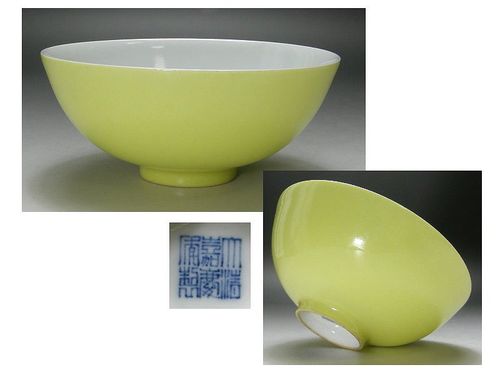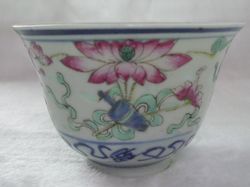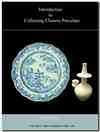Identifying Chinese Porcelain
Process of
identifying Chinese porcelain ...
Before the last Chinese imperial dynasty ended in 1911 the expression of
crafts and arts followed mostly tradition and was limited to some
degree by imperial guidelines and other factors. One of the latter was probably the method with which arts and crafts were taught in Far
Eastern societies since ancient times, not allowing for free expression or creativity. Apprentices would rather be copying the works of their
master or other masters rather than creating their own works.
Kilns produced porcelain to order for export or domestic use; they would produce many similar items in sometimes huge quantities as required. The painting of decorations was usually done by several different painters, each painting different content details. For example some would only paint the landscape, others the buildings, the people, boats, plants, etc. The whole production process was more often than not a collaborative manual mass production than an artistic creation process.
 |
Only from the republic period onwards, after the old ways started to decline did artistic expression become possible, and shapes and decorations slowly
became more variegated. A major cause of this was possibly the
increased exposure to foreign cultures. |
| Identifying
Chinese porcelain involves more than just knowing the mark in order to decide age and manufacturer, as many novices do believe. See a comparison of Chinese and non-Chinese marks. The identification and authentication of Chinese porcelain is a complex process of an overall verification of a number of factors. All experienced collectors know that with Chinese porcelain the mark is the last to be looked at. |
Identifying Chinese porcelain items, including evaluation of age and/or manufacturing period, always involves, among other, shape, decoration
and several other features that serve as reference points. These are also important for further evaluation, once an item is established
a genuine antique.
The overall evaluation takes into
account sveral the following points:
- Shape
- Color(s)
- Decoration style
- Foot (foot rim & base area)
- Glaze
- Age and/or usage signs
- Mark
- Era-related production traces
Shapes
Since porcelain was first produced, but especially after the Song dynasty, its
forms and shapes were often confined to certain shapes. While shapes may have had some
minor variations during different dynasties or reigns, or according to the kiln which may them, deviations remained within certain limits. These factors assist us when we need to identify from which era or kilns porcelain items are.
Kitchen and table wares remained more or less the same due to their utilitarian purpose and association
with the eating and drinking habits of the people.
Decorative items
like vases, jars and ceramic containers of all sizes and forms were
often subject to more change.
When visually identifying Chinese porcelain, the Shape is always the first thing that meets the eye. A short glance over a vase or jar, for example, often allows an expert of Chinese ceramics to assert or discard the possibility of a Chinese object being antique.
|
Some shapes
or curves, like those found in Japanese Sake jars
or tea cups, are rare or non-existent among Chinese ceramics
of old, yet they can be found on modern fakes. |
 |
Colors
If the shape passes this first step of inspection, an examination will most
likely include a short evaluation of the decoration and color(s) used. Here again,
certain colors (pigments) or combinations of these were just not available in
earlier times, or were out of supply at times, for example due to trading prohibitions during specific periods. Therefore, the presence of a color or colors that will
not fit a specific period of production, will result in an item being
classified as a later item, a reproduction or fake.
Some of the earliest painted porcelain color decorations of porcelain were made
in blue and red color on a white ground. But, even the blue color tone
differed depending on whether the blue mineral pigments used were of the imported type, mined
domestically, or was a mix of both.
As imports weren't available at all
times, this color itself also helps the identification or dating of Chinese
antiques. See antique
china categories for color information according to
decoration type.
Decoration
If the item passes a color inspection, then the decoration will
probably be scanned for any signs of acceptable or unacceptable styles
or patterns. Variations and different painting styles also do provide important era-specific
hints.
Foot /Base
Checking the foot rim and base of an item provides the most relevant indications
in view to age and/or approximate time of production (dating). The production
process was subject to continuous improvement over the centuries. The
presence or absence of production traces or features pointing to certain techniques
can be an important means to clarify authenticity of porcelain. Also, foot rim shape and characteristics were different from period to period, and they often are decisive in dating or authentication, respectively.
Glaze
The
glaze provides some hints as to the age, as it was different and
evolving over time, and may have been subjected to elements (soil, sea,
air).
Clay
As
with the glaze the clay/slip was gradually refined and in the 18th
century its quality was at the peak. However, it declined somewhat
after that. Some defects therefore may not show in porcelain of the
18th century.
Age signs
Finally, the whole item is checked for
the appropriate age signs. Here again, some points involving the
techniques (e.g. kiln firing, etc.) developed over time can be included
in the overall evaluation when identifying Chinese porcelain.
|
Marks |
 |
Home » Identifying Chinese Porcelain
Updated Oct. 2025

